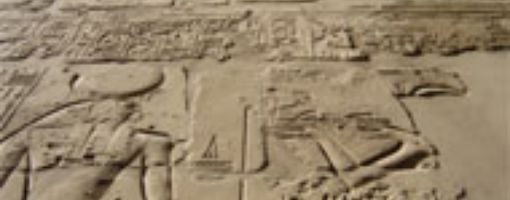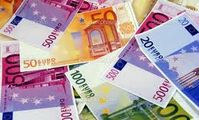HIEROGLYPHIC WRITING

Right from the beginning the deciphering of the mysterious Egyptianwriting fascinated everybody. In 1799 a certain Captain Bouchard of the FrenchArmy was supervising work on the fortifications of Fort St. Julian, situated alittle more than four kilometers outside the town of Rosetta when hisworkmen discovered a stone which was destined to achieve great fame inarcheological history. It was in fact the «Rosetta Stone» which led to thedeciphering of the hieroglyphs.
Asa result of the fortunes of war this precious stone fell into the hands of theBritish who gave it a place of honor in the British Museum. On one face of thestone, a tablet of extremely hard black basalt, there is a long trilingualinscription, the three texts being written one above the other. The firstof the inscriptions, 14 lines long, is written in hieroglyphs. The second, 32lines long, is written in demotic, from the Greek word «demos» meaning people,which refer to a type of script used by ordinary people. (Demotic is contrastedwith hieratic, from «hieros» meaning sacred, whose use was restricted topriests and scholars). The third inscription, 54 lines long, is in Greekand hence was comprehensible. This latter text, translated without difficulty,proved to be a priestly decree in honor of Ptolemy Epiphanes which finishes witha formal instruction that « this decree, engraved on a tablet of hardstone, in three scripts, hieroglyphic, demotic and Greek, shall be engraved ineach of the great temples of Egypt ».
The honor of deciphering the hieroglyphs fell to two scholars, theEnglishman Thomas Young and the Frenchman Francois Champollion who started workon it at almost the same time and who was to see their efforts crowned withsuccess. However Champollion probably has a greater right than his rival to beregarded as the man who deciphered the hieroglyphs. What Young achieved byinstinct Champollion achieved by scientific method and with such success that byhis death in 1832 he could leave behind him a grammar and a very substantialdictionary of ancient Egyptian. But what did this writing that the Greeks calledhieroglyphic, from « hiero glyphica », that is « sacred signs », actuallyconsist of? The ancient Egyptians themselves called their written texts « thewords of the gods ». In fact according to tradition men were taught to write bythe god Thot himself during the reign of Osiris. Down through the centuries thewriting retained a sacred character and more or less magical powers.Anybody who knew how to write the approxi mately seven hundred signs which constituted Egyptian writing, eachsign representing a sound or an object, was held in great esteem. The namesof the kings and queens were surrounded by an outline which archeologists call a« cartouches ». It was precisely from the names of Cleopatra and Ptolemy,engraved inside their « cartouches » on the Rosetta Stone, that Champollionstarted his long work on the deciphering of the hieroglyphs. The ancientEgyptians either engraved the hieroglyphs in the stonework of their temples orpainted them on the walls of the burial chambers or inscribed themwith a reed pen on rolls of papyrus, the antecedent of ourpaper.
Your Rating:
Overall rating: 0.000
Totally voted: 0
Comments
Weather in:
Exchange Rates
-
IMF loan expected next month
Apr 22, 2013, rating: 3.000, 3 votes Egypt may secure an International Monetary Fund loan agreement in about amonth, state news agency MENA reported, quoting "informed" sources ...
Egypt may secure an International Monetary Fund loan agreement in about amonth, state news agency MENA reported, quoting "informed" sources ...
-
Egypt received 11 million tourists in 2012 and aims to boost that number to 14 million in 2013.
Jan 22, 2013, rating: 3.000, 2 votes
Egypt received 11 million tourists in 2012 and aims to boost that number to 14 million in 2013.
-
Egypt limits travelers leaving country to US$10,000 in cash
Dec 26, 2012, rating: 3.250, 4 votes Egypt has banned travelers from carrying more than US$10,000 in foreigncurrency cash in or out of the country ...
Egypt has banned travelers from carrying more than US$10,000 in foreigncurrency cash in or out of the country ...
-
National Coalition on Climate Change for Egypt is born
Nov 30, 2012, rating: 5.000, 1 votes The global COP18 conference on climate change opens in Doha Monday.About 17,000 participants from all over the world ...
The global COP18 conference on climate change opens in Doha Monday.About 17,000 participants from all over the world ...
-
Judgment for sexual harassment
Nov 14, 2012, rating: 3.600, 5 votes A man was sentenced to two years in prison and fined LE 2,000 for sexually harassing a woman, an ...
A man was sentenced to two years in prison and fined LE 2,000 for sexually harassing a woman, an ...
-
Scientists are enthusiastic about hydrogen's green applications
Nov 13, 2012, rating: 4.000, 3 votes
As fossil fuel reserves decrease, many countries are turning to hydrogen as one of the main sources of alternative energy ...








